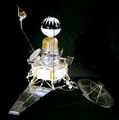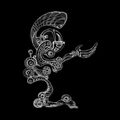Template:Selected anniversaries/January 28: Difference between revisions
No edit summary |
No edit summary |
||
| Line 1: | Line 1: | ||
<gallery> | <gallery> | ||
||1533 | ||1533: Paul Luther born ... scientist. | ||
File:Ludolf van Ceulen.jpg|link=Ludolph van Ceulen (nonfiction)|1540: Mathematician and fencer [[Ludolph van Ceulen (nonfiction)|Ludolph van Ceulen]] born. He will spend a major part of his life calculating the numerical value of the mathematical constant π. | File:Ludolf van Ceulen.jpg|link=Ludolph van Ceulen (nonfiction)|1540: Mathematician and fencer [[Ludolph van Ceulen (nonfiction)|Ludolph van Ceulen]] born. He will spend a major part of his life calculating the numerical value of the mathematical constant π. | ||
||Giovanni Alfonso Borelli | ||1608: Giovanni Alfonso Borelli born ... physiologist, physicist, and mathematician. He contributed to the modern principle of scientific investigation by continuing Galileo's practice of testing hypotheses against observation. | ||
||Johannes Hevelius | ||1611: Johannes Hevelius born ... a councillor and mayor of Danzig (Gdańsk). As an astronomer, he gained a reputation as "the founder of lunar topography", and described ten new constellations, seven of which are still recognized by astronomers. Pic. | ||
||1622 | ||1622: Adrien Auzout born ... astronomer and instrument maker. | ||
||Johannes Hevelius | ||1687: Johannes Hevelius dies ... was a councillor and mayor of Danzig (Gdańsk). As an astronomer, he gained a reputation as "the founder of lunar topography", and described ten new constellations, seven of which are still recognized by astronomers. Pic. | ||
||1701 | ||1701: Charles Marie de La Condamine born ... mathematician and geographer. | ||
||Samuel Thomas von Sömmerring | ||1830: Samuel Thomas von Sömmerring dies ... physician, anatomist, anthropologist, paleontologist and inventor. Sömmerring discovered the macula in the retina of the human eye. His investigations on the brain and the nervous system, on the sensory organs, on the embryo and its malformations, on the structure of the lungs, etc., made him one of the most important German anatomists. | ||
File:Sekiya Seikei.jpg|link=Sekiya Seikei (nonfiction)|1855: Geologist [[Sekiya Seikei (nonfiction)|Sekiya Seikei]] born. He will be one of the first seismologists, influential in establishing the study of seismology in Japan and known for his model showing the motion of an earth-particle during an earthquake. | File:Sekiya Seikei.jpg|link=Sekiya Seikei (nonfiction)|1855: Geologist [[Sekiya Seikei (nonfiction)|Sekiya Seikei]] born. He will be one of the first seismologists, influential in establishing the study of seismology in Japan and known for his model showing the motion of an earth-particle during an earthquake. | ||
||1864 | ||1864: Émile Clapeyron dies ... physicist and engineer. | ||
File:Nikolai Tesla 1896.jpg|link=Nikola Tesla (nonfiction)|1883: Electrical engineer [[Nikola Tesla (nonfiction)|Nikola Tesla]] invents method of converting alternating current (AC) into [[Gnomon algorithm functions]], revealing new techniques for preventing [[crimes against mathematical constants]]. | File:Nikolai Tesla 1896.jpg|link=Nikola Tesla (nonfiction)|1883: Electrical engineer [[Nikola Tesla (nonfiction)|Nikola Tesla]] invents method of converting alternating current (AC) into [[Gnomon algorithm functions]], revealing new techniques for preventing [[crimes against mathematical constants]]. | ||
| Line 26: | Line 26: | ||
File:Henrietta Bolt.jpg|link=Henrietta Bolt|185: Space pilot and alleged time-traveller [[Henrietta Bolt]] predicts that [[Auguste Piccard (nonfiction)|Auguste Piccard]] will "grow up to reach amazing heights, then go on to reach amazing depths." | File:Henrietta Bolt.jpg|link=Henrietta Bolt|185: Space pilot and alleged time-traveller [[Henrietta Bolt]] predicts that [[Auguste Piccard (nonfiction)|Auguste Piccard]] will "grow up to reach amazing heights, then go on to reach amazing depths." | ||
||1886 | ||1886: Hidetsugu Yagi born ... engineer and academic. He wrote several articles that introduced a new antenna designed by his colleague Shintaro Uda to the English-speaking world. Pic. | ||
|| | ||1888: Louis Joel Mordell born ... mathematician, known for pioneering research in number theory. Pic. | ||
|| | ||1889: Joseph-Émile Barbier dies ... astronomer and mathematician, known for Barbier's theorem on the perimeter of curves of constant width. | ||
|| | ||1910: Alfredo Capelli dies ... mathematician who discovered Capelli's identity. | ||
| | ||1903: Dame Kathleen Lonsdale born ... crystallographer who proved, in 1929, that the benzene ring is flat by using X-ray diffraction methods to elucidate the structure of hexamethylbenzene. She was the first to use Fourier spectral methods while solving the structure of hexachlorobenzene in 1931. | ||
||1922 | ||1922: Robert W. Holley born ... biochemist and academic, Nobel Prize laureate. | ||
||1925 | ||1925: Raja Ramanna born ... physicist and politician. | ||
||1932 | ||1932: Japanese forces attack Shanghai. | ||
||Richard Baldus | ||1945: Richard Baldus dies ... mathematician, specializing in geometry. Pic. | ||
||1945 | ||1945: Maxwell Fuller dies ... chess player. | ||
File:Nikolai Luzin stamp.jpg|link=Nikolai Luzin (nonfiction)|1950: Mathematician, theorist, and academic [[Nikolai Luzin (nonfiction)|Nikolai Luzin]] dies. He contributed to descriptive set theory and aspects of mathematical analysis with strong connections to point-set topology. | File:Nikolai Luzin stamp.jpg|link=Nikolai Luzin (nonfiction)|1950: Mathematician, theorist, and academic [[Nikolai Luzin (nonfiction)|Nikolai Luzin]] dies. He contributed to descriptive set theory and aspects of mathematical analysis with strong connections to point-set topology. | ||
| Line 52: | Line 52: | ||
File:Ranger 3-4-5 probe.jpg|link=Ranger 3 (nonfiction)|1962: [[Ranger 3 (nonfiction)|Ranger 3]] space probe misses the moon by 22,000 miles (35,400 km). | File:Ranger 3-4-5 probe.jpg|link=Ranger 3 (nonfiction)|1962: [[Ranger 3 (nonfiction)|Ranger 3]] space probe misses the moon by 22,000 miles (35,400 km). | ||
||1986 | ||1986: Space Shuttle program: STS-51-L mission: Space Shuttle Challenger explodes after liftoff, killing all seven astronauts on board. | ||
File:Klaus Fuchs.jpg|link=Emil Julius Klaus Fuchs (nonfiction)|1988: Physicist [[Emil Julius Klaus Fuchs (nonfiction)|Emil Julius Klaus Fuchs]] dies. He was convicted of supplying information from the Manhattan Project to the Soviet Union during and shortly after the Second World War. | File:Klaus Fuchs.jpg|link=Emil Julius Klaus Fuchs (nonfiction)|1988: Physicist [[Emil Julius Klaus Fuchs (nonfiction)|Emil Julius Klaus Fuchs]] dies. He was convicted of supplying information from the Manhattan Project to the Soviet Union during and shortly after the Second World War. | ||
||1993 | ||1993: Helen Sawyer Hogg dies ... astronomer and academic. | ||
| | ||2012: Roman Juszkiewicz dies ... astrophysicist whose work concerned fundamental issues of cosmology. Pic. | ||
|| | ||2015: Yves Chauvin dies ... chemist and academic, Nobel Prize laureate. | ||
|| | ||2017: John Norman Mather dies ... mathematician at Princeton University known for his work on singularity theory and Hamiltonian dynamics. Pic. | ||
File:Burglars excerpt 1.jpg|link=Burglars (Gnomon Chronicles)|2018: Signed first edition of an [[Burglars (Gnomon Chronicles)|excerpt from "Burglars"]] sells for two and a half million dollars in charity auction to benefit victims of [[crimes against mathematical constants]]. | File:Burglars excerpt 1.jpg|link=Burglars (Gnomon Chronicles)|2018: Signed first edition of an [[Burglars (Gnomon Chronicles)|excerpt from "Burglars"]] sells for two and a half million dollars in charity auction to benefit victims of [[crimes against mathematical constants]]. | ||
Revision as of 08:52, 18 September 2018
1540: Mathematician and fencer Ludolph van Ceulen born. He will spend a major part of his life calculating the numerical value of the mathematical constant π.
1855: Geologist Sekiya Seikei born. He will be one of the first seismologists, influential in establishing the study of seismology in Japan and known for his model showing the motion of an earth-particle during an earthquake.
1883: Electrical engineer Nikola Tesla invents method of converting alternating current (AC) into Gnomon algorithm functions, revealing new techniques for preventing crimes against mathematical constants.
1884: Physicist and explorer Auguste Piccard born. He will make record-breaking hot air balloon flights, with which he will study Earth's upper atmosphere and cosmic rays, and invent of the first bathyscaphe.
185: Space pilot and alleged time-traveller Henrietta Bolt predicts that Auguste Piccard will "grow up to reach amazing heights, then go on to reach amazing depths."
1950: Mathematician, theorist, and academic Nikolai Luzin dies. He contributed to descriptive set theory and aspects of mathematical analysis with strong connections to point-set topology.
1961: Brainiac Explains lecture series spends ten weeks on New York Times bestseller list.
1962: Ranger 3 space probe misses the moon by 22,000 miles (35,400 km).
1988: Physicist Emil Julius Klaus Fuchs dies. He was convicted of supplying information from the Manhattan Project to the Soviet Union during and shortly after the Second World War.
2018: Signed first edition of an excerpt from "Burglars" sells for two and a half million dollars in charity auction to benefit victims of crimes against mathematical constants.
2016: Steganographic analysis of Lend a Hand unexpected reveals "at least half a megabyte" of encrypted data relating to organic golem technology.










